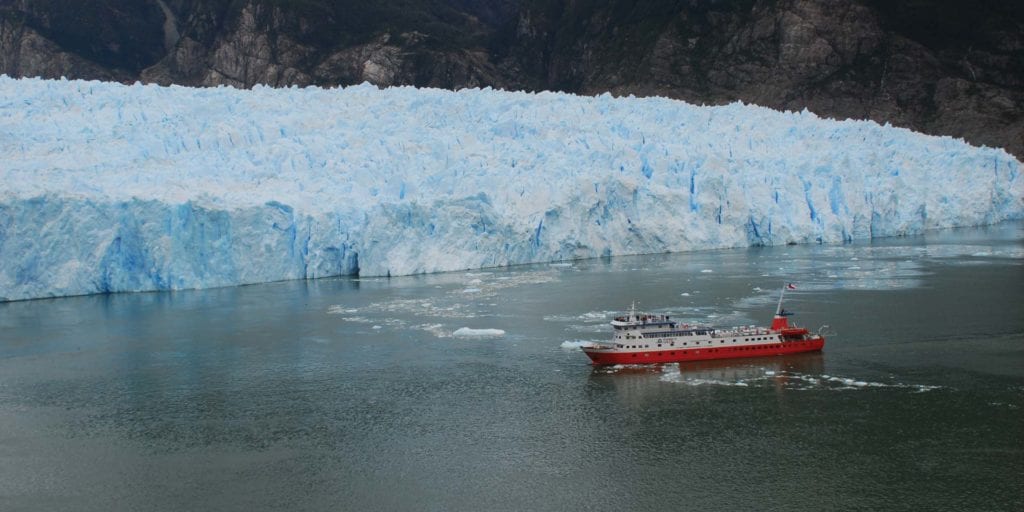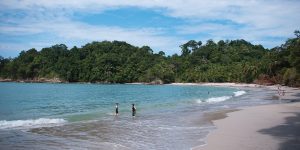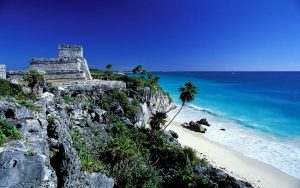Day 1 Punta Arenas/Cruise
Board the Stella Australis or Ventus Australis at 6pm. After a welcoming toast and introduction of captain and crew, the ship departs for one of the remotest corners of planet Earth. During the night, you will cross the Strait of Magellan and enter the labyrinth of channels that define the southern extreme of Patagonian. The twinkling lights of Punta Arenas gradually fade into the distance as you enter the Whiteside Canal between Darwin Island and Isla Grande de Tierra del Fuego.
Day 2 Ainsworth Bay – Tuckers Islets/Cruise
By dawn the ship is sailing up Seno Almirantazgo, a spectacular offshoot of the Strait of Magellan that stretches nearly halfway across Tierra del Fuego. The snow-capped peaks of Karukinka Natural Park stretch along the north side of the sound. While the south shore is defined by the deep fjords and broad bays of Alberto de Agostini National Park. Go ashore at Ainsworth Bay, which harbours copious bird life and a colony of southern elephant seals which can sometimes be spotted from the Zodiacs. Two guided excursions are available today. One is along the edge of a stream, peat bog and beaver habitat inside a pristine sub-polar forest. The other is a more strenuous hike along the crest of a glacial moraine. Both afford views of Marinelli Glacier and the Darwin Mountains.
Leaving Ainsworth Bay behind, sail west to the Tucker Islets. After lunch, board the Zodiacs again for a close-up view of the Magellan penguins that inhabit the tiny islands. More than 4,000 penguins use Tucker as a place to nest, give birth and nurture their chicks. Many other bird species also frequent the area including king cormorants, oystercatchers, Chilean skuas, kelp geese, dolphin gulls, eagles and even the occasional Andean condor. In September and April -when the penguins live elsewhere- this excursion is replaced by a short walk to a glacier at nearby stunning Brookes Bay.
Day 3 Pia Glacier – Glacier Alley/Cruise
Overnight sail around the western end of Tierra del Fuego via the very narrow Gabrial Channel, Magdalena Channel and Cockburn Channel. After rounding the remote Brecknock Peninsula, Stella Australis tacks eastward and enters the Beagle Channel again. By morning you will be entering Pia Fjord and boarding the Zodiacs for a shore excursion to Pia Glacier. After disembarking, take a short hike to gain a panoramic view of the spectacular glacier, which extends from the mountaintops down to the sea or a longer much more difficult walk up a lateral moraine of the old Pia Glacier.
Back on board the ship, continue east along the Beagle Channel through an area called Glacier Alley. The passage features a number of impressive tidewater glaciers flowing down from the Darwin Mountains and Darwin Ice Sheet on the north shore. Most of them named after European countries- Holland, Italy, Germany, Spain and France.
Day 4 Wulaia Bay & Cape Horn/Cruise
During the early morning, navigate the narrow Murray Channel between Navarino and Hoste islands and drop anchor at historic Wulaia Bay, one of the few places in the archipelago where the human history is just as compelling as the natural environment. Originally the site of one of the region’s largest Yámana aboriginal settlements, the bay was described by Charles Darwin and sketched by Captain FitzRoy in the 1830s during their voyages on the HMS Beagle. This area is also renowned for its mesmerising beauty and dramatic geography. After a visit to the Australis-sponsored museum in the old radio station which is especially strong on the Yámana people and European missionaries in the area. Passengers have a choice of three hikes (of increasing degrees of difficulty) that ascend the heavily wooden mountain behind the bay. On all of these, you will be strolling through an enchanted Magellan forest of lengas, coigües, canelos, ferns, and other endemic fauna to reach a panoramic viewpoint overlooking the bay. Before leaving Wulaia Bay, drop something into the wooden mail barrel inside the museum – letters or postcards meant to be hand-delivered by future travellers – an ancient mariner tradition revived by Australis.
In the afternoon, you will cruise across Nassau Bay into the remote archipelago that includes Cape Horn National Park. Weather and sea conditions permitting, you shall go ashore on the windswept island that harbours legendary Cape Horn. Discovered in 1616 by a Dutch maritime expedition, Cape Horn is a sheer 425-meter high rocky promontory overlooking the turbulent waters of the Drake Passage. Before the creation of the Panama Canal, it was the only navigation route between the Pacific and Atlantic, often referred to as the “End of the Earth.” The park was declared a World Biosphere Reserve by UNESCO in 2005. The Chilean navy maintains a permanent lighthouse on the island, staffed by a lightkeeper and his family, as well as the tiny Stella Maris Chapel and modern Cape Horn Monument.
Day 5 Ushuaia
The following morning, sail into Argentine waters and dock in Ushuaia, the world’s southernmost city. Arrival at 08:30 a.m. or 9:30 am according to date of departure.




















































